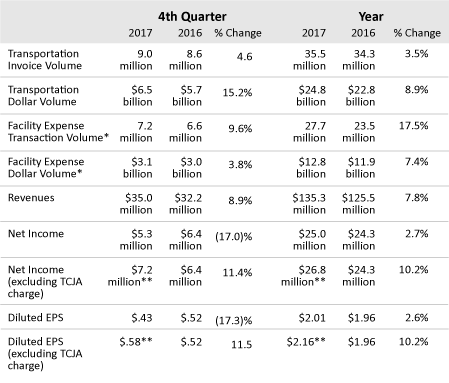ST. LOUIS - February 1, 2018 - Cass Information Systems, Inc. (NASDAQ: CASS), the nation's leading provider of transportation, energy, telecom and waste invoice payment and information services, today announced fourth quarter and full year 2017 earnings.
Those results (detailed in the table below) are skewed by a one-time, non-cash charge to income tax expense of $1.8 million triggered by the passage of the Tax Cuts and Jobs Act (TCJA) on December 22, 2017. While the reduction in the federal corporate tax rate negatively impacted 2017 earnings, the rate reduction is projected to significantly boost after-tax earnings in the future.
The table that follows presents key 2017 fourth quarter and full-year performance metrics. Net Income and Diluted EPS (earnings per share) show comparative entries that reflect the impact of the TCJA one-time non-cash charge. None of the other metrics were impacted by the charge.

*Includes Energy, Telecom and Waste
**Non-GAAP
2017 Q4 Revenue Up 9%
Cass posted a healthy 9% increase in revenue in the fourth quarter as it continued to grow its customer base, expanded new revenue-generating services and benefitted from an improving interest rate environment. The company continued to foster service innovation with investment in new technology and infrastructure.
Highlighting fourth quarter performance was a 15% increase in transportation dollar volume. Against the backdrop of a strengthening global economy, increased carrier and fuel prices combined with higher volume from current accounts to produce the notable result. Transportation invoice volume was also up 5% for the period.
Facility-related (electricity, gas, waste, and telecom expense management) transactions increased 10% due to new customer wins and increased volume from current accounts. Facility expense dollar volume grew by 4% for the period.
Consolidated operating expenses were up $2.2 million (9%) due mainly to on-going strategic investment in the technology and staff required to win and support new business.
“We are delighted that 2017 proved to be another record-setting year for Cass, despite our need to absorb the significant accounting charge generated by federal tax reform legislation,” stated Eric H. Brunngraber, Cass chairman and chief executive officer. “Excluding that charge, Cass achieved a 10.2%* increase in net income and earnings per share for 2017.”
*Non-GAAP
Cash Dividend Declared
On January 30, 2018, the company’s board of directors declared a first quarter dividend of $.24 per share payable March 15, 2018 to shareholders of record March 5, 2018. Cass has continuously paid regularly scheduled cash dividends since 1934. Additionally, Cass has returned more than $22 million to shareholders over the past three years through its share repurchase program.
“The positive impact on future earnings from tax reform combined with our strong balance sheet and sound operating performance leave our board of directors upbeat about what the future holds for Cass,” Brunngraber commented.
About Cass Information Systems
Cass Information Systems, Inc. is a leading provider of integrated information and payment management solutions. Cass enables enterprises to achieve visibility, control and efficiency in their supply chains, communications networks, facilities and other operations. Disbursing over $50 billion annually on behalf of clients, and with total assets of $1.6 billion, Cass is uniquely supported by Cass Commercial Bank. Founded in 1906 and a wholly owned subsidiary, Cass Bank provides sophisticated financial exchange services to the parent organization and its clients. Cass is part of the Russell 2000®. More information is available at www.cassinfo.com.
Note to Investors
Certain matters set forth in this news release may contain forward-looking statements that are provided to assist in the understanding of anticipated future financial performance. However, such performance involves risks and uncertainties that may cause actual results to differ materially from those in such statements. For a discussion of certain factors that may cause such forward-looking statements to differ materially from the company’s actual results, see the company’s reports filed from time to time with the Securities and Exchange Commission including the company’s annual report on Form 10-K for the year ended December 31, 2016.
